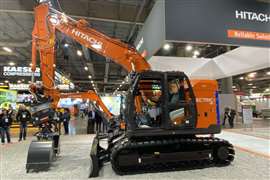Top of the towers
15 February 2017

As cities become more densely packed with new high rise buildings on increasingly congested sites the luffing jib tower crane is coming into its own. Linden Comansa has revealed the latest and largest addition to its luffing jib tower crane range. Alex Dahm went to see it...
Many cities around the world are home to increasing numbers of luffing jib tower cranes. To name but a few, New York, Sydney, Bangkok, Chicago, London and Seoul can appear on that list. Where air space is limited the benefits offered by a luffing jib crane with minimum tail swing and the shortest out of service radius are very important.
At the same time, on these often congested sites, the required weight of the loads being lifted is also increasing. Having larger pieces and sections assembled on the ground, prior to lifting, makes for faster construction. Better quality control is possible and assembling on the ground rather than in the air is safer for workers. So large steel beams and heavy precast concrete panels are becoming the norm. All of this makes larger luffing jib tower cranes and increasingly attractive proposition and one that looks likely to continue upwards.
In response, Spanish tower crane manufacturer Linden Comansa has expanded its large luffing crane range upwards with the addition of a 700 tonne-metre class model. The LCL700 sits in the range above the LCL500 and it is available in two versions. Both the 64 and 50 tonne capacity models are designed to operate with two falls of rope. There is a simple manual changeover to single line operation for faster lifting cycles. On this one fall of rope capacities are 32 and 25 tonnes, respectively.
Smaller Linden Comansa luffing models have triangular section, three-sided, booms. On the LCL700 this is now a square boom for more lifting capacity. It starts at 30 m long and can be extended in 5 m increments to a maximum of 65 m. At that maximum the 50 tonne version lifts 7.5 tonnes and the 64 tonner 7.2 tonnes.
The minimum lifting radius is 4 m. To help minimise space requirements on congested sites the standard rear counter jib radius is 9.5 m. It can be reduced to 8.7 m by opting for steel counterweights instead of the standard concrete ones. The concrete slabs are the same as on the smaller LCL500 model. The minimum out of service radius is shown on the data sheet as 16 m with a 40 m boom. On the full 65 m boom it is 20 m.
In a further departure from conventional luffing jib tower crane design, the main hoist winch is placed in front of the foot of the boom, next to the cabin. This allows a simpler and more direct path for the rope to follow with less reeving. It also leaves more space on the rear of the machinery platform for access to the luffing winch and electrical cabinets. The 200 kW frequency-controlled hoist winch operates at up to 170 m/min. The LCL700 64 t lifts 64 tonnes at 17 m/min as 34 m/min is the maximum for a 32 tonne load on a single fall of rope. Capacity on the Lebus grooved drum is 1,270 m (1.27 km!) of hoist rope.
Maximum free standing height is 69.8 m on an anchored base. In terms of tower sections it has benefits for fleet owners of several Comansa cranes. It uses the same 2.5 x 2.5 m D36 mast sections as its smaller brother, the LCL500, and on the 21LC750, a large 48 tonne capacity, flat top tower crane model. Also the same is the climbing cage type J3-18.
On the subject of assembly and transport, the complete counter jib weighs 18.5 tonnes. A feature to help speed up erection is that the luffing rope pulleys are in a pack that comes pre-reeved from the factory. Erection ropes are fitted between the backmast and boom. To transport a 64 tonne capacity LCL700 with 65 m jib requires 20 trucks or 19 standard containers plus one open top container.






